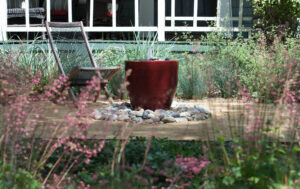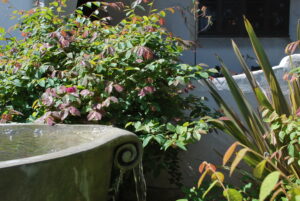Water features, adding soft splashes of water to your landcape, create a focal point and a sense of calm. Much like natural bodies of water, water features allow you to connect with the environment and find peace. While there are many benefits to having a water feature, it is wise to consider your surroundings when you choose to have one. If you live in a warmer climate, consider these tips to ensure that your water feature is water-wise:
 Choose a Cooler Location
Choose a Cooler Location
When deciding where to place a water feature, look to shadier parts of your landscape, either covered by trees or a pergola. By putting a water feature in the part of the landscape not directly exposed to the sun, you prevent excess evaporation, allowing the water in you water feature to remain continuously flowing.
Think About Wind
Just like exposure to too much sun, water features exposed to too much wind will lose water due to wind evaporation. By adding certain plants, such as shrubs or tall grasses to your landscape, you can prevent further evaporation by wind. Even placing your water feature near to, or constructing new, fences and other forms of blockades, you can prevent wind evaporation.
Consider the Flow
The type of flow your water feature has also makes a difference. Water features with water either flowing downward or flowing up in a slow trickle lose less water to evaporation than those with water bursting upwards.
Important Adjustments
If you already have a water feature that sprays water out the top, it’s not too late to make your water feature more water-wise. You can turn down the level of water coming out so that it’s less exposed to air and evaporation.
Alternatively, if there’s a reservoir of water that the water feature is pouring into, you can fill the reservoir with less water, so less water splashes out.
Take Some Time Off
One of the best things you can do is turn off your water feature when you’re not using it. If you’re not enjoying the outdoors or having company over, flip the switch to save some water.
Check for Cracks
It’s also important to ensure that you’re not losing water from cracks in your water feature. The best way to ensure that there are no cracks is to mark the side of your water feature with a grease pencil where the water line is. Check again in 24 hours and see if the water is roughly where it was. If not, you may have a crack.
 Water features add a lovely element to your landscape. By following these few steps, you not only ensure that the feature keeps running as it should, but save water in dryer areas or areas experiencing a drought.
Water features add a lovely element to your landscape. By following these few steps, you not only ensure that the feature keeps running as it should, but save water in dryer areas or areas experiencing a drought.
